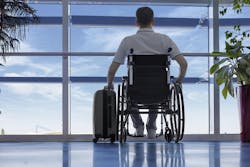Collins Aerospace offers solution for passengers with reduced mobility
WINSTON-SALEM, N.C. - Collins Aerospace, an RTX business in Winston-Salem, N.C. will unveil its cabin solution for onboard wheelchair accommodation at the annual Aircraft Interiors Expo in Hamburg, Germany. The Collins product is compatible with most WC19 and ISO 7176-19 transport-certified powered wheelchair devices, allowing passengers with reduced mobility (PRM) an inflight experience more equivalent to that of able-bodied passengers.
Collins Aerospace's wheelchair seating solution designed to improve comfort and dignity for wheelchair users on flights without reducing aircraft cabin density. The system involves a restraint mechanism installed at the front of narrow-body aircraft, allowing wheelchair users to remain in their chairs during the flight. On-board crews can easily secure the wheelchair without needing maintenance staff.
"Enabling motorized wheelchair users to remain in their chair is imperative to providing a more equitable and dignified air travel experience to the millions of people who rely on personal mobility devices in their everyday lives," said Cynthia Muklevicz, vice president of customer and business development for Collins Aerospace. "Innovating solutions that enhance the inflight and cabin experience is fundamental to the mission of Collins. We're confident this certifiable solution will help eliminate barriers, opening greater possibilities to a wider population to more conveniently experience the excitement and necessity of air travel."
The solution also simplifies the boarding and deplaning process, reducing the risk of injury and discomfort from transferring individuals in and out of their wheelchairs. It minimizes mishandling during check-in, handling, and stowage. Tests at the National Institute of Aviation Research (NIAR) showed the boarding process with this solution is similar to ground transportation, aligning air travel with other transportation modes.
The installation involves an integrated restraint system and seat belt attachments securing both the wheelchair and passenger, which can be stowed when not in use. This system uses unused space, maintaining existing seat configurations and densities.
